Create
Vintage St. Pete: The Playhouse Theatre
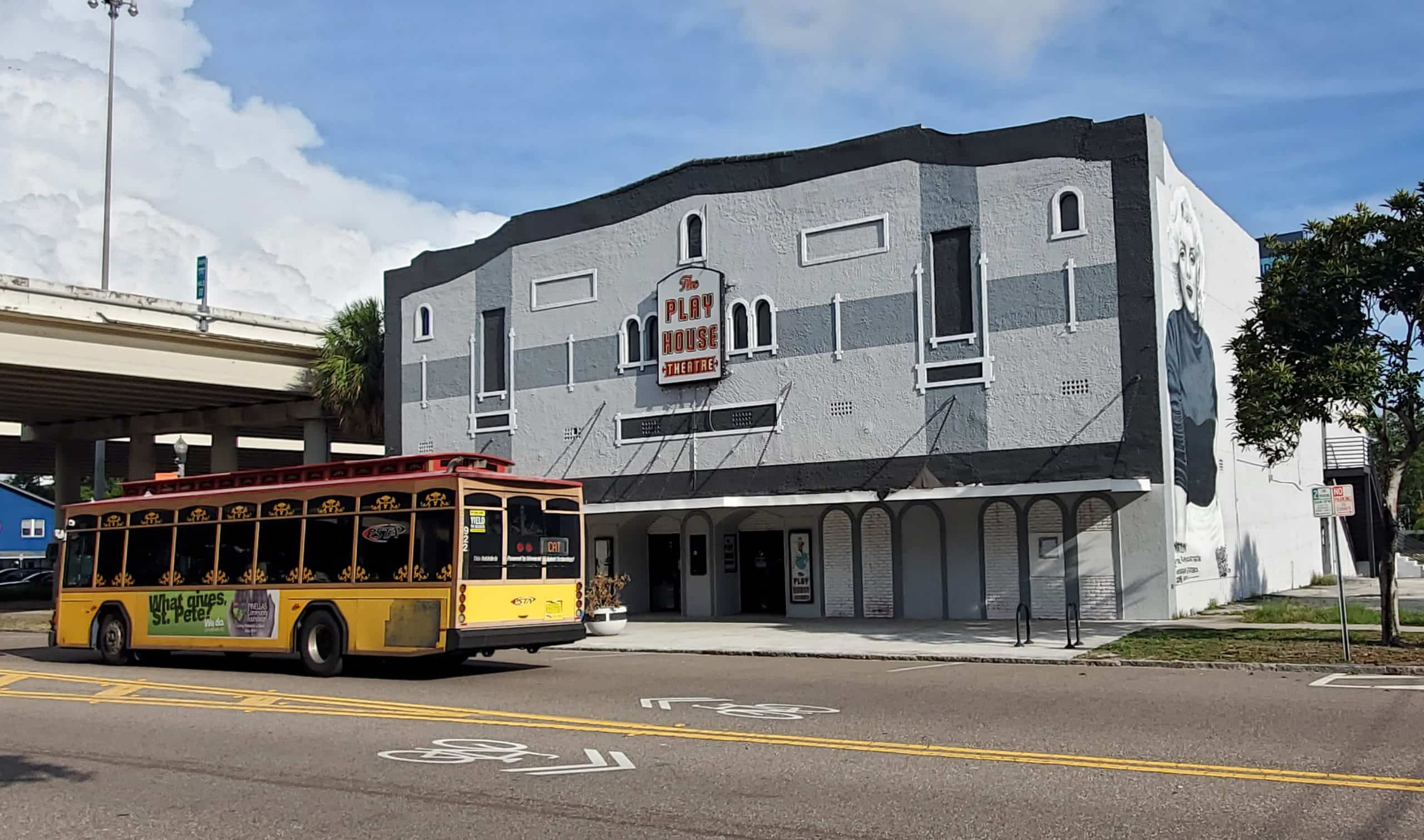
The wrecking ball has a date with the crumbling concrete, brick and stucco building at 1850 Central Avenue, next to the I-275 overpass, and it’s going to happen before the 100th anniversary of its construction rolls around in 2025.
There’s no historical designation for the old Playhouse Theatre, just decades of ghosts and laughs and memories, all of which will be chased out when work begins on a brand-new urology office. The sale was finalized in April; the demolition permit, according to city records, has been applied for.
Pre-dating the Vinoy, the Don CeSar and the Million Dollar Pier, the Playhouse was a center of leisure and entertainment in St. Petersburg for nearly half a century before the stink of decay set in. Attempts to rehab and revitalize the place worked, with varying degrees of success, but by the turn of the century the writing was on the stained interior wall.

St. Petersburg Evening Independent, July 3, 1925. Courtesy the St. Petersburg Museum of History.
In today’s St. Pete, it is an anachronism. And it is nobody’s child.
Built “in the Spanish style” by 31-year-old New York amusement broker Anthony Shimko, the Patio Theater, as it was first known, opened Aug. 8, 1925. The Patio wasn’t St. Pete’s first movie house, but it was, according to the St. Petersburg Times, the “first to be erected outside of the congested district,” meaning downtown.
A seven-piece orchestra supplied the music for the silent pictures flickering on the Patio screen. The “house band” also performed for concert nights, traveling vaudeville shows and other special events.
 “High Class Motion Pictures! Centuria’s Celebrated Orchestra!” read a Patio advertisement.
“High Class Motion Pictures! Centuria’s Celebrated Orchestra!” read a Patio advertisement.
In that first year, an adjustable steel roof was added, allowing for closed-ceiling screenings when necessary, and alternately to cool patrons in those steamy days before air conditioning.
Shimko re-designed the Patio in 1928, adding palm trees, ferns, custom draperies, a pipe organ and painted clouds and stars on the new ceiling. The big night, Oct. 28, included a Pathe newsreel about a German zeppelin’s arrival in New York, the Mack Sennett comedy The Bicycle Flirt, a silent feature called The Four Flusher with George J. Lewis and Marion Nixon, and an introductory program from “the Patio’s eight dancing beauties.”
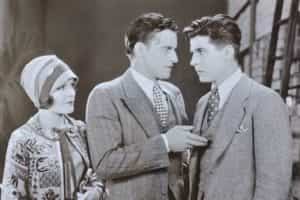
“The Four Flusher”
The era of “talkies” arrived, and the Patio, like the half-dozen other movie houses in the city, was re-fitted for the new technology. It was briefly known as the Ritz.
In 1935, with the arrival of impresario Raymond Moore (“and his company of Broadway players!”) the theater, following a $12,000 renovation, was re-named the Playhouse. Moore launched a program of live theater on the proscenium stage.
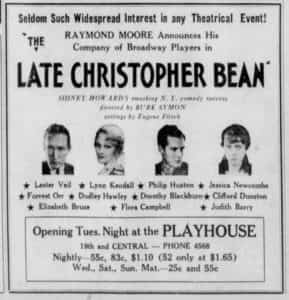
The war years brought a mixed program of movies, theater, touring variety shows and the occasional big name – in 1945 alone, Ernest Tubb, Tex Ritter and a “Grand Ole Opry” revue (with Minnie Pearl and Pee Wee King) performed, in separate concerts.
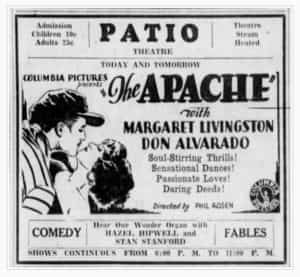 Three years later, air conditioning was installed. “Cool, constant temperatures are now making movie going more delightful at the Playhouse Theatre,” crowed the Times. Co-owners Bill and Bob Boardman told the newspaper they’d laid out $32,000 for the unit (“the equivalent of melting 100,000 pounds of ice every 24 hours!”) and other renovations, including a pair of state-of-the-art Simplex/RCA lamps and projectors (“Technicolor films will especially be improved by these lamps”).
Three years later, air conditioning was installed. “Cool, constant temperatures are now making movie going more delightful at the Playhouse Theatre,” crowed the Times. Co-owners Bill and Bob Boardman told the newspaper they’d laid out $32,000 for the unit (“the equivalent of melting 100,000 pounds of ice every 24 hours!”) and other renovations, including a pair of state-of-the-art Simplex/RCA lamps and projectors (“Technicolor films will especially be improved by these lamps”).
 The next renovation, in 1963, brought plush, wider new seats and an enlarged lobby. According to Bill Boardman, the layout this time was $25,000.
The next renovation, in 1963, brought plush, wider new seats and an enlarged lobby. According to Bill Boardman, the layout this time was $25,000.
 But competition was fierce, and as St. Petersburg expanded to the west and to the north, away from downtown and the Central Avenue area, movie theaters began to appear like squirrels in suburbia. By the mid ‘60s, downtown and surrounding neighborhoods were turning “old” St. Pete into a ghost town.
But competition was fierce, and as St. Petersburg expanded to the west and to the north, away from downtown and the Central Avenue area, movie theaters began to appear like squirrels in suburbia. By the mid ‘60s, downtown and surrounding neighborhoods were turning “old” St. Pete into a ghost town.
In 1966, Boardman reduced admission to one dollar; as many as three children would be admitted free when accompanied by a paying adult.
 The first “adult” feature arrived in 1967, before the “X” rating had even been created, and for the next six years the Playhouse catered to the “dirty old men in raincoats” crowd, showing titles like Booby Trap, Acapulco Uncensored, Hot Pearl Grab and Swinging Stewardesses.
The first “adult” feature arrived in 1967, before the “X” rating had even been created, and for the next six years the Playhouse catered to the “dirty old men in raincoats” crowd, showing titles like Booby Trap, Acapulco Uncensored, Hot Pearl Grab and Swinging Stewardesses.
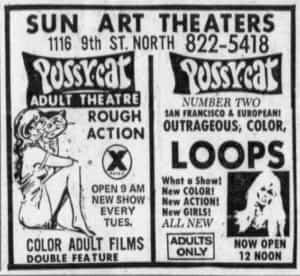 This was the nadir of St. Petersburg’s decline, as the Playhouse wasn’t even the top sleaze factory in town – porn purveyors could visit the Cameo (where Deep Throat caused a sensation in ’73), or the Sun Art (“Pussycat One” and “Pussycat Two”), the Center, the Palms on Park Boulevard or even Pinellas Park’s Mustang Drive-In, when “skin flicks” were a regular attraction.
This was the nadir of St. Petersburg’s decline, as the Playhouse wasn’t even the top sleaze factory in town – porn purveyors could visit the Cameo (where Deep Throat caused a sensation in ’73), or the Sun Art (“Pussycat One” and “Pussycat Two”), the Center, the Palms on Park Boulevard or even Pinellas Park’s Mustang Drive-In, when “skin flicks” were a regular attraction.
Youth minister Freddie Langston bought the building, for $90,000, and in 1974 opened a teen nightclub he called Papa’s Dream.
Realizing that the very concept behind Papa’s Dream would turn off the alienated teens he hopes to reach, Langston insists on a religion-free atmosphere. “We’re not going to use this place as a calling card to entice a lot of teens inside, then zap them with a bunch of religious junk,” Langston emphasizes. “I think we can reach these alienated teens by giving them the best music in town at the lowest prices.”
St. Petersburg Times/Sept. 23, 1974
The club’s schedule did include, however, a weekly Bible study class.
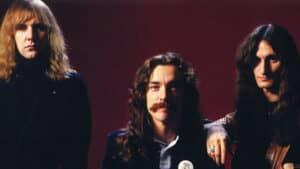
Rush, 1973
The Canadian rock trio Rush, then on its first American tour (opening arena shows for Kiss), was the opening-night headliner at Papa’s Dream. Just 250 “alienated teens” turned up, and according to Times writer Carolyn Nolte-Watts, “Audience reception was lukewarm at best. Too many covered their throbbing ears to escape the painful noise level.”
Then came disco, and punk, and the other cultural upheavals of the late 1970s. After the (perhaps inevitable) decline and fall of Papa’s Dream, producers Bob Turoff and Ben Schrif bought and re-fit the building yet again, and christened it the Golden Apple Dinner Theatre (they already operated a Golden Apple location in Sarasota, so this was No. 2). Opening was Jan. 15, 1981.
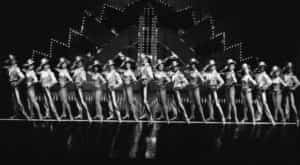
“A Chorus Line,” Encore Dinner Theatre, late ’80s. Promotional photo.
Unfortunately, this dovetailed with the decline in public interest in dinner theaters – both of St. Petersburg’s veteran “dinner and a show” houses, the Showboat and the Country Dinner Playhouse, would start to run out of gas by mid-decade.
In 1989, the Golden Apple became Encore Dinner Theatre – and within two years, the curtain came down. For good.
Extra Innings Ballpark Café struck out, as did Concert Central, a hip hop-focused martini bar.
The Nahakama Group, an investment company, purchased all 14,610 square feet of the block in 2016, and performed cosmetic rehabilitation on the Playhouse façade to attract potential buyers (“it was pretty much an eyesore,” contractor Ronnie Powell told the Times).
A new marquee sign was installed, and framed, faux-vintage playbills were screwed into the walls facing Central. The Vitale Brothers painted a black and white mural of Marilyn Monroe on the western wall.
In the final act, it wasn’t some showbiz sharpie with big ideas and a big budget who bought the Playhouse Theatre. The honor went to Penncap LLC, a company formed by St. Pete Urology physicians Dr. Reid Graves and Dr. Nicholas Laryngakis.
Graves and Laryngakis’ LLC paid $2.7 million for the Playhouse, along with a neighboring, smaller venue (at 1833 1st Ave. S) and two vacant commercial lots to the west.
“At closing, they weren’t sure what they were keeping and what was coming down,” said PaulaClair Smith, Colliers Commercial Real Estate Services’ managing director, who brokered the deal.
Nobody’s in a rush to tear the Playhouse down. “There’s no set timeline,” Smith added. Graves and Laryngakis did not immediately return calls for comment.
Still, with the demo permit filed away at City Hall, it seems all too clear the Playhouse Theatre will not make its 100th birthday.
“The majority of buyers I had for it were all what I call dreamers,” Smith said. “You know, they all had visions of restoring the venue to its quote-unquote previous glory. Or into something really ‘cool,’ you know?
“But it was just too expensive. It was just too much, to do that.”

The interior of the Playhouse in 2021. Visible, behind the remains of Extra Innings Ballpark Cafe and Concert Central Martini Bar, is the original proscenium stage. Shannon Herod/GetRealEstatePhotos.com.






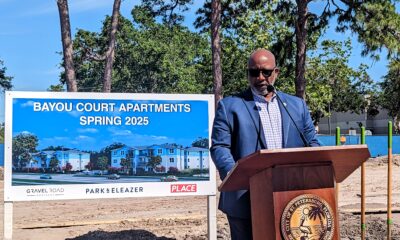

Scott Simmons
July 4, 2021at3:37 am
Thanks Bill, wonderfully done. The only thing missing was the balcony. Before I got my driver’s license in 1966, a date and I would take a bus down town for a movie and a kiss or two. I recall the balcony at the Playhouse was my favorite place to not watch the movie. I live in Mexico full time now and don’t plan to return to the states. Your articles let me keep up with my old home town.
Scott Simmons
July 4, 2021at3:33 am
Thanks Bill, wonderfully done. The only thing missing was the balcony. Before I got my driver’s license in 1966, a date and I would take a bus down town for a movie and a kiss or two. I recall the balcony at the Playhouse was my favorite place to not watch the movie. I live in Mexico full time now and don’t plan to return to the states. Your articles let me keep up with my old home town. We are making new memories in San Miguel de Allende, but the old ones you bring to mind mean so much. Please keep up the great work. Curious about when and where African Americans were permitted to watch a movie.
Kevin Travells
July 2, 2021at5:22 pm
Steve remembered the 21st day of September
Steve Allen
July 2, 2021at10:15 am
Rumor has it RUSH played there in 74 on their first tour of North America.
Bill DeYoung
July 2, 2021at1:55 pm
Hey Steve: Yep, Sept. 21, 1974. For 250 people. A story in the Times said it was uncomfortably loud.